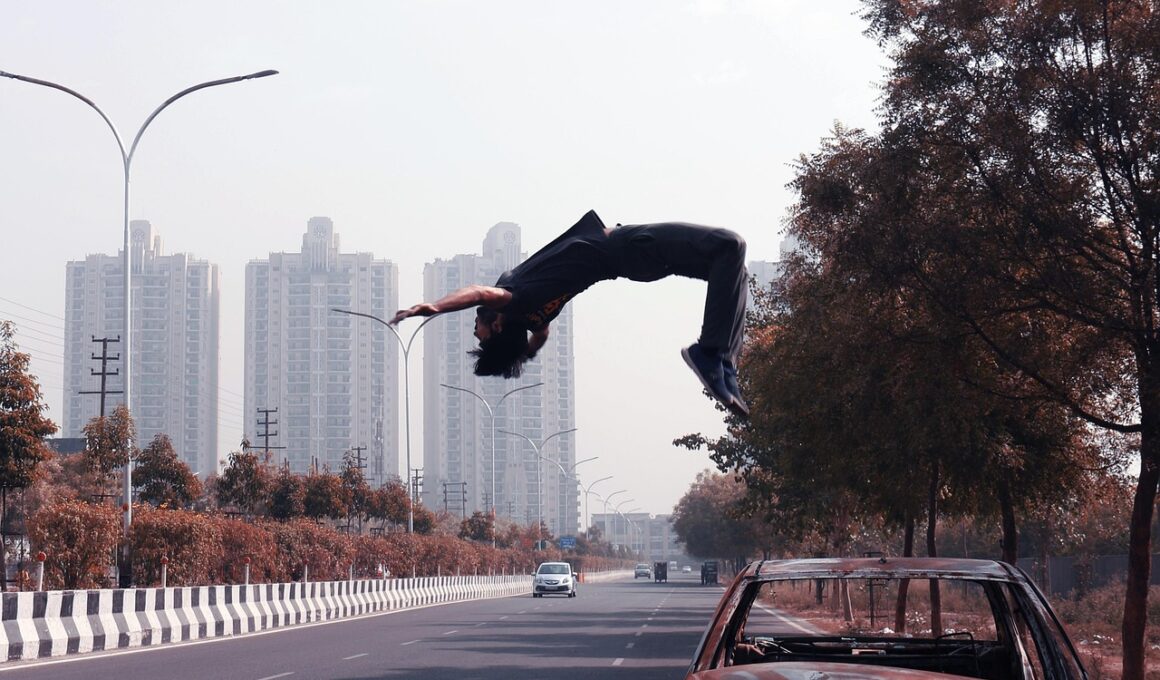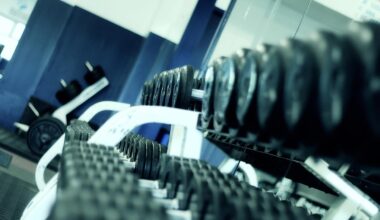Advanced Parkour Training Plans for Experienced Athletes
If you’re an experienced parkour athlete looking to enhance your skills, developing an advanced training plan is crucial. Prioritize building strength, agility, and endurance for optimal performance. Start with dynamic warm-ups focusing on mobility to prepare your body. Incorporate plyometric exercises such as box jumps and depth jumps to improve explosive power. These exercises increase quickness when performing parkour moves. Next, work on upper body strength through movements like muscle-ups and handspring variations. This training will aid in executing complex vaults and flips. Incorporate conditioning, such as long-distance runs and interval sprints, to enhance cardiovascular stamina. Practicing parkour techniques is vital; emphasize precision and controlled landings to boost your confidence. Set specific goals for each training session, such as mastering a new movement or increasing the height of your jumps. Consistency is key; train at least four times per week. Create a balance between strength training and skill practice. Analyze your technique through video to identify and improve areas requiring refinement. Seek guidance from experienced coaches for personalized feedback. The right training plan will set you on the path to mastery in advanced parkour.
Training sessions can be broken down into focused areas for further improvement. One essential aspect of your regimen should be strength training paired with skill-based exercises. By emphasizing various jumping techniques, you can enhance your performance over time. Create a schedule including specific vaults, flips, and wall runs to achieve consistent practice. Include time for drills, ensuring you can repeat movements until mastered. In addition to traditional exercises, consider learning how to incorporate creative elements into your practice. Freerunning combines parkour skills with artistic expression, so experiment with different movements. Integrating acrobatics can elevate your skills while keeping training exciting and fresh. Balance static and dynamic exercises for optimal muscle development. Switching up routine keeps your mind engaged, potentially preventing boredom. Depending on availability, utilize different locations to challenge yourself, such as urban settings, parks, or vacant lots. Each location presents new obstacles to navigate, enhancing spatial awareness. Additionally, incorporate recovery strategies to avoid burnout or injury. Always listen to your body. Nutrition also plays a significant role in performance; fuel your workouts with adequate protein and hydration for optimal recovery.
Skill Progression Techniques
Progression in parkour involves continually setting new challenges and improving existing skills. Establish a hierarchy of movements based on your comfort level. Start with basic vaults, then gradually progress to more complex ones. For example, practice precision jumps before attempting a kong vault. Concurrently, incorporate teamwork into your training by partnering with other athletes. Having a training buddy can enhance motivation and provide valuable feedback. Work together on group exercises, encouraging one another through supportive competition. Additionally, consider cross-training with other disciplines such as gymnastics or martial arts. These sports can offer different perspectives on body movement, helping develop your skills. Consistently reflecting on your technique and recording your progress can help identify areas needing improvement. Setting small, achievable goals will keep you motivated and focused on the path ahead. Don’t shy away from trying new challenges, as they foster growth. Celebrate your accomplishments along the way, whether learning a new move or refining your technique. This positive reinforcement can significantly impact your mindset. Finally, never forget the importance of safety; practice in a controlled environment while wearing appropriate gear.
Mental conditioning can be just as critical as physical training in parkour. To overcome fear and enhance focus, consider practicing mindfulness techniques during your sessions. Visualization can also play an important role; imagine successfully executing movements before attempting them. Incorporate gradual exposure by starting with lower heights and simpler techniques. As confidence grows, you can tackle more challenging obstacles. Regularly practice breathing exercises to maintain calm during high-pressure scenarios, aiding concentration before challenging movements. Developing a strong mental game will significantly improve your overall performance. Reflect on your training experiences to foster personal growth. Analyzing setbacks encourages resilience and adaptability. Journaling your progress and feelings during training can provide insights into your challenges and successes. Allow time for rest, as burnout can negatively affect your mental state. Seek feedback from peers and mentors, as their insights can provide new perspectives. Regularly re-evaluate your goals to align them with your current abilities. This ensures ongoing motivation and growth. Parkour training is a lifelong journey, so embrace the process and enjoy every moment. By nurturing both physical and mental aspects, you can unlock new heights and achieve your parkour aspirations.
Nutritional Considerations for Parkour Athletes
Nutrition is a crucial element in the performance of parkour athletes. A balanced diet fuels your body, ensuring you have the energy needed for intensive training. Focus on incorporating lean protein, complex carbohydrates, and healthy fats in your meals. Foods rich in vitamin D and calcium will aid bone health, essential for high-impact movements. Meal timing is equally significant; consuming something light before training can enhance energy levels, while a post-workout meal facilitates recovery. Hydration should never be overlooked; staying hydrated can directly impact performance and recovery. The right supplements can also play a role in supporting your training regimen. Consider using branched-chain amino acids or protein powders if needed, but consult with a nutritionist for personalized advice. Be diligent in monitoring your body’s response to different foods, as everyone reacts differently. Understanding your metabolic needs may require some experimentation. Staying within a proper caloric range will promote muscle growth and necessary energy production. Moreover, create a meal plan that fits your lifestyle, making it easier to stick to. Learning to prepare nutritious snacks will ensure healthful choices between training sessions, contributing to long-term success.
Injury prevention strategies are essential for all athletes to pursue parkour safely. Incorporating warm-up routines and cooldown stretches is non-negotiable; these practices prepare muscles while promoting recovery. Learning to listen to your body when it signals discomfort can prevent minor injuries from escalating. Allowing sufficient rest or modifying exercises when fatigue sets in can significantly reduce injury risk. Be observant during training; maintaining proper form during movements is vital. Poor technique often leads to strain and injury. Additionally, train on appropriate surfaces, such as grass or rubber mats, to minimize impact. Using suitable footwear also provides needed support and traction during practice. Remember that muscle imbalances can contribute to injuries; a balanced strength training program will help avoid this. Regularly consulting with a professional trainer or therapist can ensure personalized strategies are tailored to your needs. Keep an eye on nutrition as it impacts recovery and injury healing. Make ice therapy routine for any swelling or pain. Understanding limitations is crucial; pushing boundaries should be done gradually and consciously. With dedication to injury prevention, you can continue progressing in parkour while maintaining overall health and wellness.
Setting Goals and Tracking Progress
Establishing clear goals is fundamental for parkour athletes on their journeys to improvement. Goals provide motivation and direction, allowing athletes to measure their growth. Start by setting SMART (Specific, Measurable, Achievable, Relevant, and Time-bound) objectives. These will guide your training and help maintain focus. Create a timeline outlining your milestones, and break down larger aims into smaller, manageable tasks. Tracking progress through journals or apps can help visualize your journey effectively. Regularly update your achievements and notes to remain engaged with your training. Seek feedback from coaches or peers to gain insights into areas needing development. Formulate alternate strategies if specific goals become challenging to reach. Celebrate even small accomplishments, as they contribute to a sense of progression. Furthermore, revisiting and modifying your goals will keep your training aligned with your evolving skills. Networking with other parkour enthusiasts can also foster a supportive community, enhancing your training experience. Discuss goals and share tips with one another for mutual growth. Be patient; mastery doesn’t occur overnight. With perseverance and a clear mindset, each goal met sparks continuous motivation, paving the way for advanced parkour excellence.
To achieve a higher level of proficiency in parkour, continuous skill refinement is vital. Dedicate time to work on specific techniques that challenge you, ensuring you don’t plateau. Engage in drills focusing on precision landings, roll mechanics, and fluidity in movement execution. Incorporate routine video analysis, allowing you to observe your progress and identify techniques that require adjustment. Study professional athletes both in-person and via instructional videos online. This exposure to various styles can broaden your understanding of parkour. Attend workshops and training camps to gain firsthand experience and learn new perspectives. These events provide opportunities to connect with like-minded individuals, fostering a sense of community. Collaborating with other practitioners can offer fresh insights while elevating your game. Consider joining local parkour meet-up groups to share knowledge and practice together. This type of experience creates a platform for peer learning. Ultimately, sharing your journey with fellow athletes adds motivation and a sense of belonging. Always remember that every parkour practitioner’s journey is unique. The key to excelling in this discipline lies in your dedication to training and consistent self-improvement.


